
views
Ensuring Ideal Conditions for Building

Pick an overcast day. An overcast day is ideal because it will keep the sand cool. Because cool sand is able to hold moisture (water) better, it is much more stable than dry sand, making it ideal for building large sandcastles.

Choose a beach with fine sand. Fine sand is much more compact (put together) than coarse sand. Compact sand provides more structure and stability. To test the compactness of a beach’s sand, ride a bike on the beach. If it is relatively easy to ride the bike, then the sand is perfect. If you don't have a bike, then press a ball of sand in your hand. Roll the ball around. If the sand sticks together after rolling it around, then it is perfect.

Add equal parts water to the sand if it is too dry. If you have a bucket of sand, add a bucket of water to it. By adding water to the sand, you can transform it into workable sand. If the sand is really dry, then add more water. Press the sand into a ball in your hand and roll it around. If the sand holds it shape, it is ready to use.

Pick a spot 1 foot (0.30 m) above the high-tide water line. A spot just above the high-tide water line is ideal because it is close to the water. This will make retrieving water from the ocean much easier. Additionally, choosing a spot above the high-tide will protect your sandcastle from approaching waves. The high-tide line is typically marked by seaweed and other ocean debris.
Building the Base
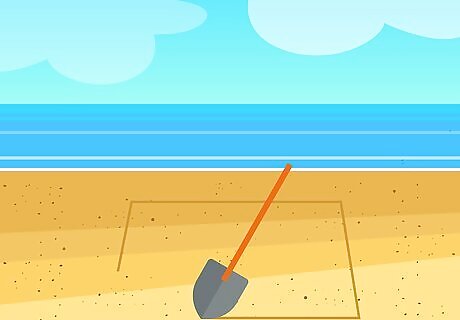
Outline an area as big as you want your sandcastle to be. If you want your sandcastle to be 5 by 5 feet (1.5 by 1.5 m), then outline a 5 by 5-foot area. Use a stick or shovel to mark the outside perimeters.

Pile 6 inches (15 cm) of sand evenly over the entire area. Use large buckets, shovels, and garden spades to pile the sand over the entire area. For the best results, use sand that is located below the tide line. This sand is typically wet and compact. Alternatively, mix one part sand with one part water in a bucket. Use this sand to create your base.
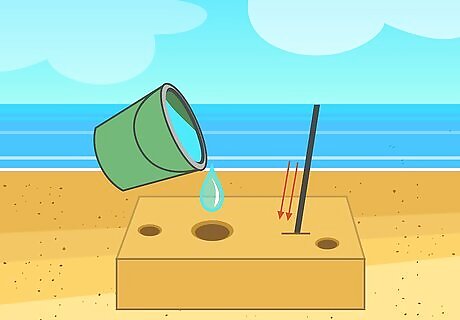
Pour water into the sand to make it compact. Use a stick to poke a grid of holes into the base of sand. Slowly pour buckets of water over the entire base. Let the water drain all the way through the sand. Pour one bucket of water for every 1 foot (0.30 m) of sand. If the sand still feels too loose or dry, then add more water.
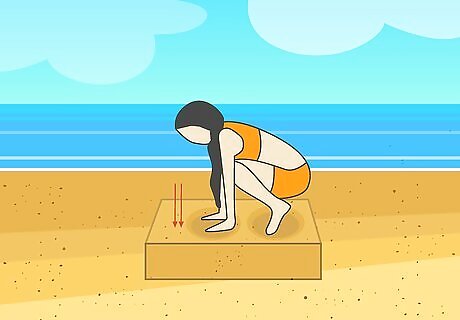
Use your hands and feet to pack the sand down. Press on the sand with your hands to pack it down. You can also use your feet to pack the sand down. Pack the sand down until it feels like a solid block beneath you. You can also roll a large bucket over the sand to pack it down.
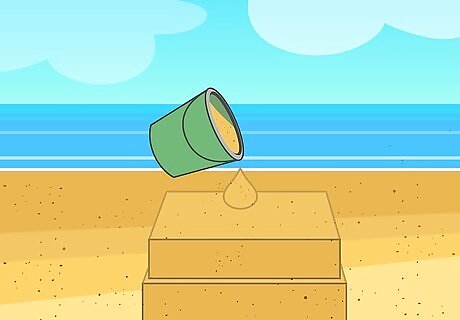
Add another 6 inches (15 cm) of sand. Use your shovels and buckets to pile more sand onto the base. Poke holes into the sand with a stick. Pour water into the sand and pack it down with your hands and feet. Keep adding sand and water until you have a solid base of sand that is at least 1 to 2 feet (0.30 to 0.61 m) high.
Creating Height
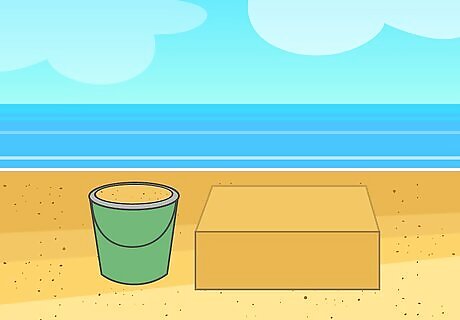
Remove the bottom of a 1 gallon (3.8 l) bucket. Using a saber or keyhole saw, cut out the bottom of the bucket. Use 40 to 60-grit sandpaper to sand the edges until they are smooth. By removing the bottom of the bucket, it will be easier to lift the bucket off of the sand. If you do not want to remove the bottom yourself, then ask the hardware store if they can do it for you. Alternatively, use a regular bucket without the bottom removed if you do not have a 1 gallon (3.8 l) bucket. You can purchase 1 gallon (3.8 l) buckets, saws, and sandpaper from your local hardware store.
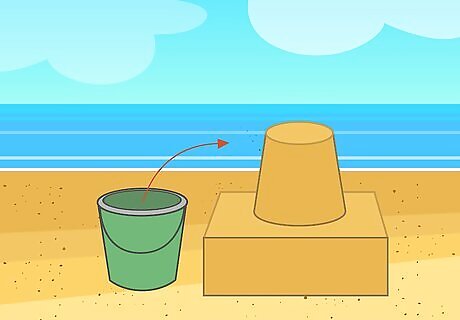
Build layers by placing the bucket upside down on the base. Fill a third of the bucket with sand. Add an equal amount of water to the sand. Pack the sand down with your hands. Repeat this process until the bucket is full of compact sand. Remove the bucket. Once the sand feels solid enough and does not give under pressure, it is compact.

Cover the entire base with a layer of compact sand. Ask you create the layers of sand, place the bucketfuls of sand close together. Fill in gaps between the bucketfuls of sand with more sand and water. Pack the sand with your hands until the base feels solid.

Add a second layer to create more height. Keep adding layers of sand until you have reached your desired height. Once you have reached your desired height, use a sand wedge hoe or a plastic knife to smooth the surface of the sand flat. Large sandcastles are typically 5 by 5 feet (1.5 by 1.5 m) or bigger. If you plan to build a sandcastle taller than you, then bring a step ladder to the beach so you can reach the top.
Carving the Castle
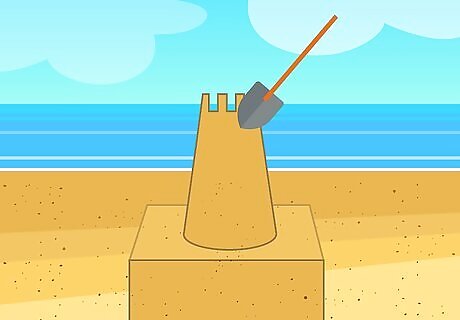
Start by carving the top of the castle. If you start at the bottom and work up, then the sand at the top will fall down onto the bottom structures, ruining them. By starting at the top, you can prevent this from happening. Work on 1-foot (.30-meter) sections at a time. Make sure to finish each section before moving onto the next section.
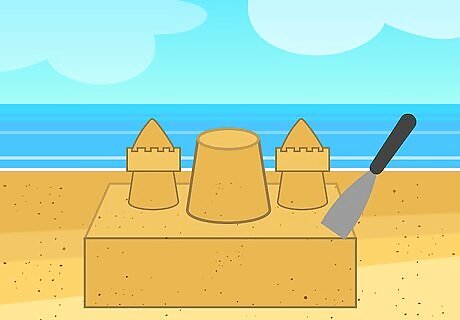
Use a putty knife to create basic shapes. Use the putty knife to carve out rounded towers and pillars. Carve out towers at the corners of your pile of sand. Carve out 2 or 4 towers. You can also use an offset spatula, a paint scraper, or an icing spatula to smooth and create the basic shapes of your castle.
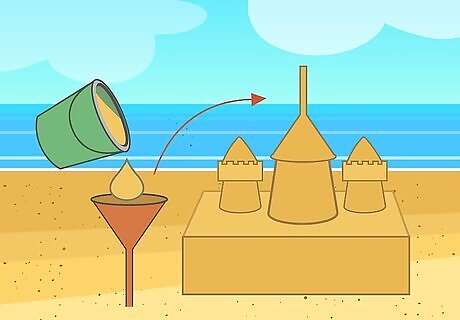
Create a peak with a funnel. Fill a funnel with compact sand. Place the funnel upside down on top of a tower. Remove the funnel by gently wiggling it from side to side until it releases the sand.

Carve a wall. To form a wall, remove 1 inch (2.5 cm) of sand between two towers. Use a paint scraper or knife to smooth and flatten the sand. Drag the bottom of a knife across the top of the wall to create slits to resemble a castle wall.
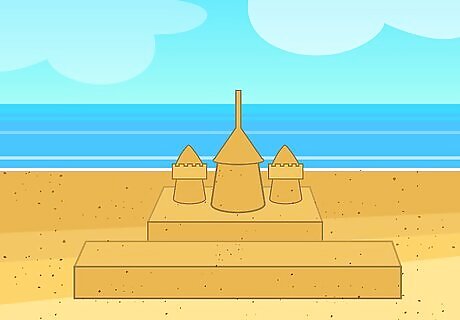
Use a sand wedge hoe to make steps. Smooth out a ramp behind a tower or in front of a wall. The ramp should be 3 to 4 inches (7.6 to 10.2 cm) wide. Place the sand hoe against the tower or wall. Drag the sand hoe across the ramp to create each step. Create steps all the way down the ramp.

Create a brick pattern with a toothpick. Draw 1-inch (2.5 cm) thick horizontal lines across the wall with the toothpick. Space out vertical lines on the first horizontal row 1 inch (2.5 cm) apart. On the second horizontal row, place vertical lines in the spaces between the lines in the first row. Repeat this pattern throughout to create an off-set brick pattern. You can also use the toothpick to create other cool patterns or designs on your sandcastle, like a diamond pattern or flower pattern. Use a fork to create ridges on the outside of your castle.
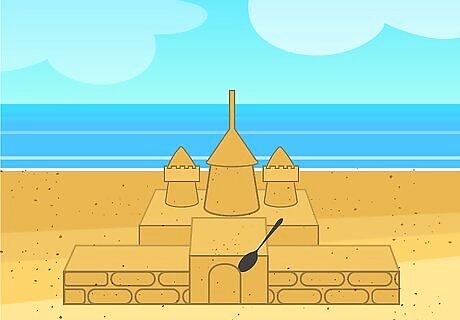
Make arched doorways with a spoon. At the bottom-center section of the wall, place the tip of the spoon on the sand. Carve the outline of an arched doorway that is 5 to 10 inches (13 to 25 cm) tall, depending on the size of your castle. Remove the sand from the inside to create an indention for the doorway. You can also use the end of the spoon to create small slits for windows on the tower and the walls.
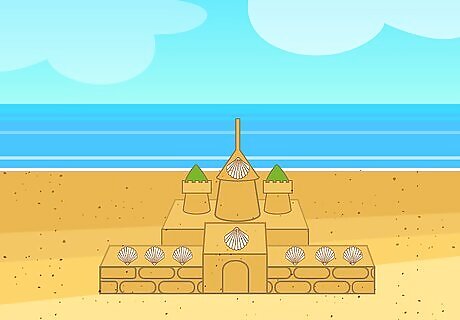
Decorate your castle with shells and seaweed. Press seashells along the walls or around the rims of the towers. Place seaweed or beach wood around the bottom of the castle. You could also place small buckets and shovels around your sand castle. Stick small flags or windmills into your castle. Light up your castle with battery-powered candle lights. Browse your local crafts store for more decoration inspiration.


















Comments
0 comment